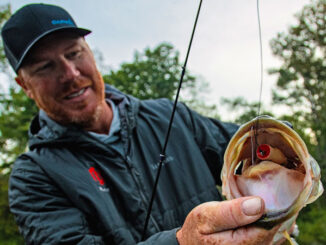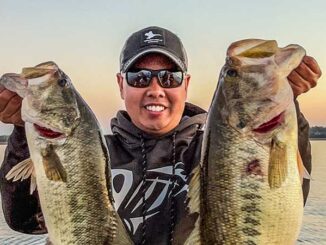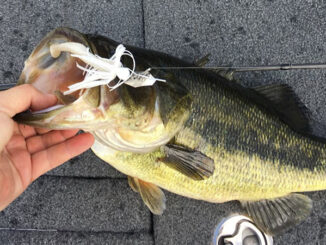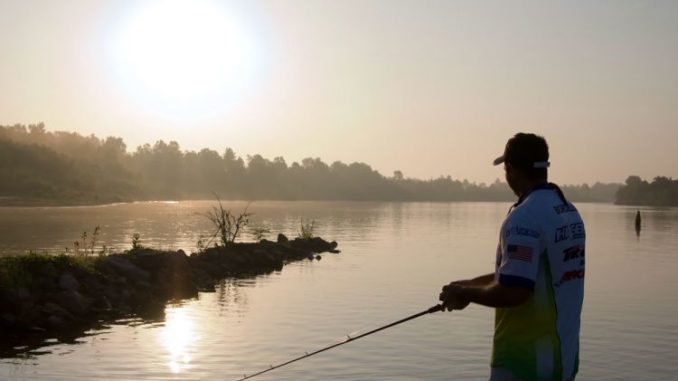
Recent floods have taken their toll on bass fishing in the Red River, but with a little cooperation from Mother Nature, there are some signs a rebound could happen.
After Chad Wiley weighed-in on the final day of the 2014 Bassmaster Central Open on the Red River, his three-day total of 34 pounds, 14 ounces landed him in fifth place.
Fast forward four years, and Patrick Walters won the entire event in 2018 with only 30 pounds, 15 ounces. Wiley finished sixth this year, with 22 pounds, 12 ounces.
“So the winning total this year was 4 pounds less than my fifth place finish in 2014,” Wiley said. “And I wound up in basically the same spot this year as I did in 2014, with 12 fewer pounds. “The Red River? To be honest it ain’t what it used to be.”
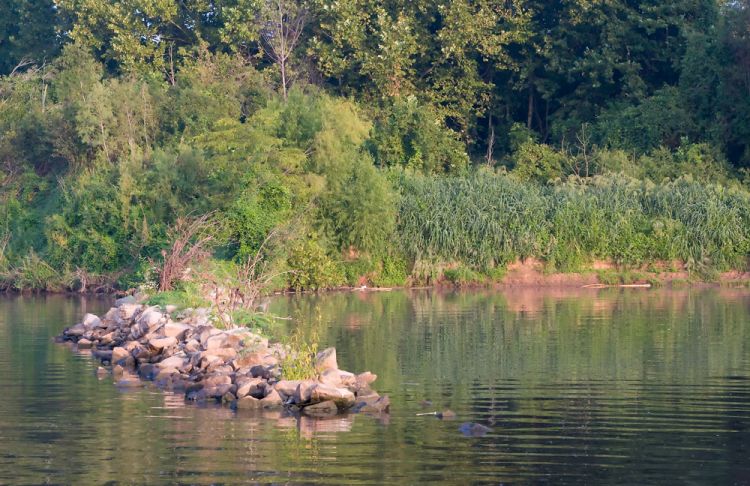
Wiley, who lives on Pool 2 in Pineville, says there isn’t a 100-yard stretch of the Red from Pool 2 to Pool 5 that he hasn’t looked at during numerous amateur and professional tournaments in which he’s competed.
What he sees today as opposed to what he saw in the recent past discourages him to the point of wanting to fish just about anywhere but the Red.
“And that’s true in every pool,” he said. “Every one of them.”
While Wiley’s most recent tournament on the Red River made him wish for the way things used to be, Red River guide Russ McVey (redriverfishing.com) has a more optimistic outlook for the future.
“It’s definitely changed,” McVey conceded. “The grass is basically gone, and a lot of the places we used to run or fish have silted in. What I do now is fish the river the way we used to fish it when it was first flooded.”
McVey explained that all he fished back then was flooded timber, which is just about all the Red River has to offer today — fishing flooded timber.
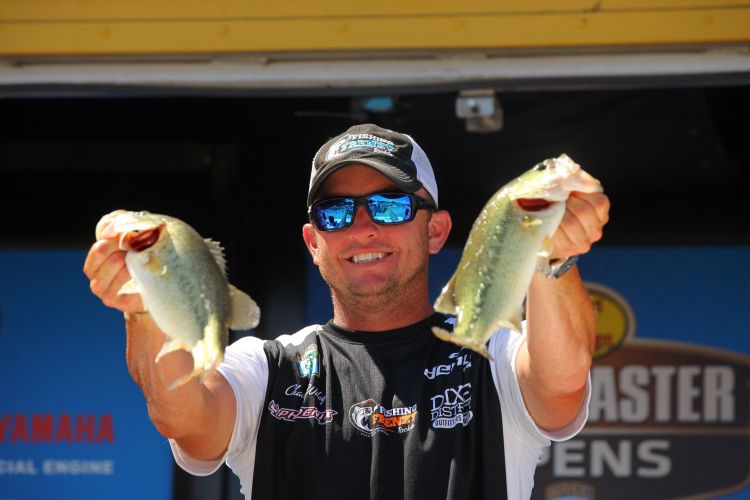
“But all bodies of water go through their ups and downs,” McVey reasoned. “I expect the Red River will come back in a couple years. It’s kind of like the Dallas Cowboys. They won all those Super Bowls, and expectations got so high nobody can stand to see what they have become. They’ll come back, though.
“The fans just have to be patient … like anglers who fish the river.”
Flooding issues
Although anglers tend to chase reasons why the Red River has changed so much, there’s no doubt the recent floods that severely impacted the region took their toll on everything from the topography to the tackle boxes.
“Twenty-fifteen was really bad,” McVey said. “And we had another one the very next year. But we’ve had high water dang near every spring since 2015.”
He feels as though Pool 5 has borne the brunt of the recent flooding, as it is the northernmost pool in the system and has caught the vast majority of silt. In his opinion, the silting, although still present, is not as bad in Pool 4 as it is in 5.
“All that silt has reduced the surface area and volume of Pool 5,” McVey said. “Where we used to have 18 or 20 feet of water, today it’s either dry ground or maybe 1 foot. Places we used to run boats have willow trees growing on them right now.”
The access to Caspiana from the main river is a perfect example. The lane that used to run just inside the rocks right off the main river is now dirt. And the north cut going into White House is now too shallow to run.
“There’s one little area you can idle through, but I dang sure wouldn’t run it,” McVey advised.
One of the aftereffects of the loss of surface area and volume in the river is that the water now is prone to getting dirty with much less disturbance than it used to take.
“When you take volume away from a body of water, it becomes more susceptible to getting dirty,” McVey said. “If it used to take a 4-foot rise to make it dirty, now it takes only a 2-foot rise.”
And the disappearance of vegetation has only exacerbated the dirty-water problem, since grass tends to act as a natural water filter.
“All the good grass is gone,” Wiley said. “And what few pads you can find, there is no grass in it — just sand and dirt. There used to be a lot of coontail around the wood, and that could help you almost call your shots. Now it’s all lying on sand. You can still fish the wood, but who knows where the fish are going to be.”
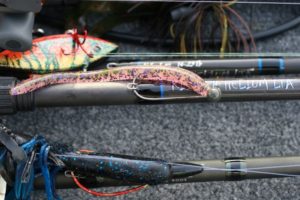
Concerning vegetation, McVey feels as though vibrant grass beds could help the fishery rebound much more quickly if they were allowed to flourish. The problem in his eyes is that whatever grass does come back, gets quickly sprayed in an effort to keep it under control.
Persistent patterns
Although the topography of the Red River has changed dramatically over the years, Wiley and McVey noticed that fishing patterns have pretty much remained the same.
In fact, Wiley’s recent sixth place finish came by running the same kind of patterns he would have run before the floods.
“The shad were spawning around wood off sandy points in the very back of an oxbow in Pool 4, so I threw spinnerbaits as long as the shad were spawning,” Wiley said. “When that was over each morning, I changed to a Texas-rigged creature bait with either a 1/8- or 3/16-ounce weight and let it soak by just barely dragging it back.”
Although he didn’t use it during the most recent Bassmaster Open, Wiley said a squarebill crankbait is still a no-brainer when fishing the Red.
“Without a doubt — never fails,” he insisted. “And just like before the floods, you can never get too shallow with them. All that high water rearranged a lot of the wood cover, but it’s still there. You crawl that squarebill through enough wood and sooner or later you’re going to put it right in front of a couple of their faces.”
Wiley didn’t fish the main river during this particular tournament, but he did mention that the remaining visible rocks still hold lots of fish — although they tend to be smaller than those in the backwaters.
One of the things he keys on when he does target the rocks is where the sand piles up.
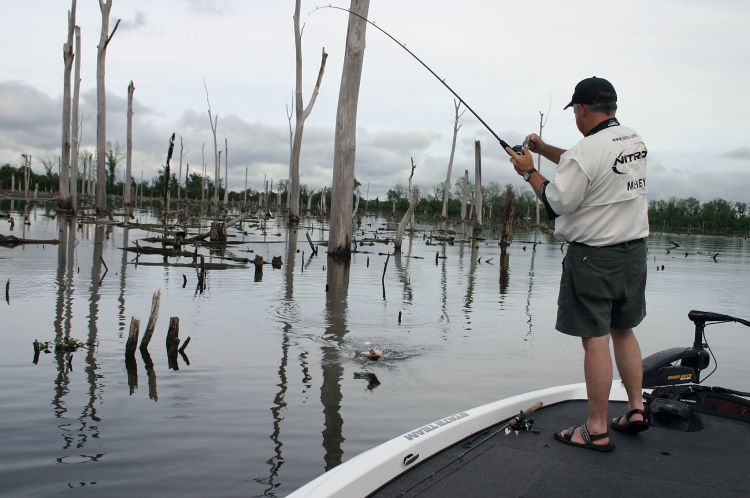
“Instead of fishing right up on the rocks,” Wiley said, “I like to run a medium-diving crankbait, or work a shaky-head worm out in a little bit deeper water where the sand starts piling up on the rocks, at what would be the shallower side of the rocks.”
McVey takes much the same approach, which he said was exactly how he used to fish the river after it was first flooded.
“All we had to fish back then was timber,” he said. “There wasn’t any grass. That meant we fished a lot of Texas-rigs, crankbaits and spinnerbaits. Topwater frogs and all that kind of stuff didn’t come into play until the grass started showing up.”
Since there’s very little to fish other than the timber now, McVey said he tries to figure out which timber is best by focusing on underwater contours and locating timber near drop-offs, points and channel ledges — any kind of depth change on the bottom.
McVey acknowledged that there were still lots of bass out on the rocks in the main river, but he was adamant that the backwaters were the place to target because of the better quality fish they hold.
“It might be harder to get to the backwaters now,” he said, “but as far as the main river versus the backwaters, bass fishermen are going to go to the fish. If that means they’ve got to idle through a shallow stump field to get to them, that’s what they’re going to do.”
Hope for the future
Things may look bleak for the Red River right now, but Wiley and McVey both agreed that there were some positive signs that the fishery could rebound in a big way.
“Take those fish out in the river for instance,” Wiley said. “I could have fished the main river in that Open tournament, but I would have finished in 60th or 70th place because I would have had 5 pounds a day. There were definitely a lot of fish out there; they were just all small.”
In fact, Wiley believes the bass that made it through all the flooding must have had a few good spawns because of the abundance of 8- to 10-inch fish in the river.
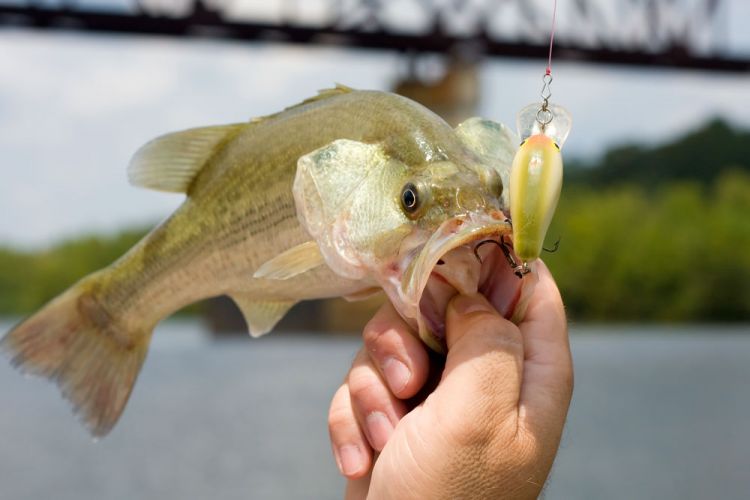
“In five or six years, it may be better again,” he said.
McVey said he wouldn’t call it a big population of small bass, but he did say that there was a respectable number of 10- to 12-inch bass that could point to good things to come.
“We’ve got to have some clean water the next couple of spawns,” he said. “I’m a firm believer that fish won’t spawn in dirty water. I may be wrong, but if we can get some clear water spawns the next couple years, I think we’d see a pretty good rebound. Of course, if they’d let the grass grow it would rebound even faster.”
Like most things that are cyclical in nature, the Red River is destined to eventually get out of the rut it’s been in and make its way back to the top of the mountain.
Will it be as good as it was before? Only time will tell.
But one thing is sure — unlike the Dallas Cowboys, it won’t stay down in the valley forever.
